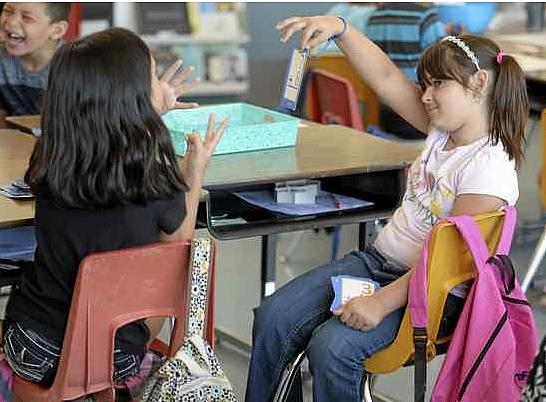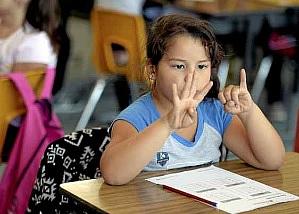Migrant ed in Solano — In Dixon Unified, a harvest of hope: Educators seek sense of ‘continuity,’ minimize problems for 350 mostly Hispanic transient kids
This article, the second in a series on Migrant Education in eastern Solano County, was produced as a project for the USC Center for Health Journalism’s California Fellowship, a program at the USC Annenberg School for Communication and Journalism. 2016 California Fellow Richard Bammer is a reporter at The Reporter in Vacaville, Calif.
Other stories in the series include:
Migrant children see themselves in California Mini-Corps teachers
Bridging ‘opportunity gap,’ migrant ed students go to STEM camp
Migrant ed in Solano — program focuses on math fluency, reading, robotics

Estefaania Orozco, 7, holds up a flash card as classmate, Karen Gomez, 7, solves the math problem Monday in their first grade class at Anderson Elementary School. Both students are part of Dixon Unified’s summer migrant education program. Joel Rosenbaum -- The Reporter
The clock’s second hand sweeps past 1:15 p.m. at the Dixon Migrant Child Development Center, and it is quiet in the aging, beige-colored, single-story school with an adjacent portable classroom. The youngest of the 95 Hispanic children enrolled, infants and toddlers, they are napping.
Dark and cool, the curtains drawn to ward off bright sunlight baking the somewhat woebegone former U.S. Navy housing area on Radio Station Road, the classrooms are where the preschoolers learn simple numbers, colors, letters, basic shapes and some English during the week while their parents work the vast outlying farms from sunrise to evening, or at the nearby Campbell soup factory or at the Superior Farms lamb-processing plant, among other places. Some of the parents and their children, blankets and toys in hand, arrive at the center as early as 5 a.m.
The older students who live at the camp, which houses more than 80 migrant families, attend either Anderson Elementary or Dixon High during Dixon Unified’s summer Migrant Education program until classes resume on Aug. 10. Those students, in grades one to 12, are bused daily to their respective schools and return after lunch, at 12:30 p.m.
Using her fingers to help her with her addition, Angela Aguirre, 7 works on a math problem Monday in Elizabeth Brown’s first grade class at Anderson Elementary School. The class is part of Dixon Unified’s summer migrant education program. Joel Rosenbaum -- The Reporter
A way of life for some 700,000 children nationwide, with some 200,000 living in California, Migrant Education is a federally funded program that responds to the educational and health needs of these children.
A law first passed in 1965, when Lyndon Johnson was president, the program is in addition to the supplemental services the children already receive through school districts, many of them serving rural areas, like the 3,500-student Dixon Unified School District, where one in 10 students is classified as migrant.
The center supervisor, Silvia Contreras, who works for San Jose-based Continuing Developing Inc., which operates migrant centers throughout California, noted that the federal dollars help to ensure that the children, while moving or relocating elsewhere for several months, are not lagging behind in their early childhood education or grade as they progress steadily — or in fits and starts — toward graduation.
The U.S. Department of Education gives migrant education dollars to state departments of education, based on each state’s per-pupil expenditure, for all migrant students up to age 21. For Dixon Unified — and in part for Contreras’ company — the money pays for administrators, teachers, remedial classes, career education services, preschool services, special guidance, counseling and testing. The federal dollars also pay for free, nutritious breakfasts and lunches during the summer program, as they do during the rest of the school year for low-income students, English language learners and foster youth.
The program’s goal is to make sure all migrant students achieve the same standards as traditional students and graduate from high school or earn a GED, a formidable task since DOE data indicates that nearly one-half of all migrant students do not pick up their diploma, troubling numbers that rival another education subgroup: American Indians.
Problems come, Contreras noted, when migrant children who attend California schools may not have their credits recognized in other states —Texas, for example — or may be placed in a lower grade when they return to school. Additionally, the children may or may not attend school in Mexico while away from the United States, and, if they do, she said, they are learning only in Spanish at rundown schools with limited resources, such as lack of up-to-date textbooks, no Internet access or computers.
Contreras, who oversees a budget of $200,000 and supervises 17 credentialed teachers, some of them former students at the center and graduates of Dixon High, said enrollment has increased slightly in the past two years.
“Families are having more babies,” she said, seated in her office, its walls lined with books and plastic binders, photos of her two adult children.
Her assistant, Carmen Salazar, said even though enrollments are up at the center, there are, by her account, fewer migrant farmworkers in the area, adding that advancements in harvesting machinery have eliminated some jobs.
“It used to be that you’d have 11 people” following a mechanical tomato harvester, today “only five,” she said. At 2:30 p.m., the older students, mostly third- to fifth-graders, are in the portable classroom, the boys playing with Legos, the girls, casting their eyes on pictured designs, glueing together colored Popsicle sticks.
Karen Gonzalez, 19, a native of Jalisco state, a former center student and a 2015 Dixon High graduate, watches the boys’ boisterous play. One of five children of a migrant farmworker father who now drives a truck, she wants to earn an early childhood education credential from Woodland Community College.
She recalled her days at the center school, ones with filled joy, creativity and “learning rules, rules that will follow you all your life.”
Co-worker Liliana Chavez, 22 and a 2012 Dixon High graduate, still lives at the camp during spring to early fall. A Fresno native, she has worked at the center for three years and wants to earn an education certificate that will permit her to work with disabled children.
Schools in Mexico are less structured than those in the U.S., a primary difference, she said.
Chavez said the center children know of her background. She believes that her greatest challenge is “being a role model” for them, telling them they can successfully complete their studies and graduate if they work hard, as she did.
Meanwhile, at Anderson Elementary, a 67-year-old school on East C Street, a few blocks off Dixon’s core downtown area, Superintendent Brian Dolan, on the day of a Reporter visit, is subbing for Tanya LaBass. She supervises several teachers in classrooms holding nearly 120 of the program’s students, kindergarten through sixth grade.
Dolan noted that, as in Vacaville Unified, which has about 130 migrant students, some of the migrant children live in the Dixon are “year-round” and not necessarily itinerant.
Overall, California districts “are doing a better job of identifying” migrant students and getting them the services they need, he said.
But in the general American population — “And even among some staff here,” said Dolan — people do not understand the kind of life many migrant children lead, how often they relocate, or the academic and health challenges they face.
“We try to give them (students) some consistency,” said Dolan, a former classroom teacher and school principal.
The so-called “achievement gap,” he believes, is a related to what some educators call the “opportunity gap,” that the poor do not have the same resources or summertime “enrichment” opportunities as middle-class or upper middle-class children have.
Frequent moves, said Dolan, create problems with the students’ “acquisition of English,” in countries, such as Mexico, where education is compulsory and free only to the sixth grade.
“For high school, the parents have to pay,” he said.
“So the kids benefit from continuity and structure,” said Dolan. “The lack of continuity makes a huge difference. They’re supposed to spend 180 days in school and any student who misses classroom time because of disruptions ... to pick up and be gone -- it’s hard to integrate back in,” he said. “There are social-emotional consequences, too, but most of the students are resilient. Being a migrant student is not some sort of (criminal) sentence.”
Around the corner from LaBass’ office, teacher Beth Kom works with 15 second-graders with the help of Aimee Carrazco, 21, a graduate of Dixon High, Dominican University and a member of the California Mini-Corps. The latter is a state Migrant Education adjunct that, employing young people, many of them children of migrant workers and aspire to teaching careers, provides tutoring to California’s migrant students during summer sessions.
Alluding to the state’s ongoing drought, Kom, working in the late morning just before lunch, has the students read a lesson called “Water Facts.”
Carrazco, a Sacramento native who eventually wants to earn a law degree, with an emphasis in immigration law, said in an interview during lunch that the students’ greatest challenge is learning English.
“But they pick it up really fast,” she said, adding that the migrant students “see us and look up to us.”
At Dixon High, migrant summer school administrator Amy Whorral oversees nearly 120 students in grades seven to 12.
Parents, she added, “are really supportive” of the summer program, during which the middle-schoolers learn English and pre-algebra and the freshman to seniors primarily strengthen their English language skills, with some enrolled for “credit recovery” so they can earn a diploma.
Migrant students, said Whorral, in her first year with the district’s summer migrant education program, struggle to complete their educations, in part, because they face obstacles and gaps in the learning of English.
It is her impression, she said, that many of them do not attend school when they return to Mexico in the fall.
[This story was originally published by The Reporter.]
Joel Rosenbaum/The Reporter.

